As a seasoned lock picking expert, I cannot stress enough the importance of having a reliable locking system. However, the effectiveness of any lock is only as good as its design and proper installation.
That’s why my fellow security enthusiasts, I’ve put together this comprehensive guide to give you an overview of 23 different types of locks and how to pick them too.
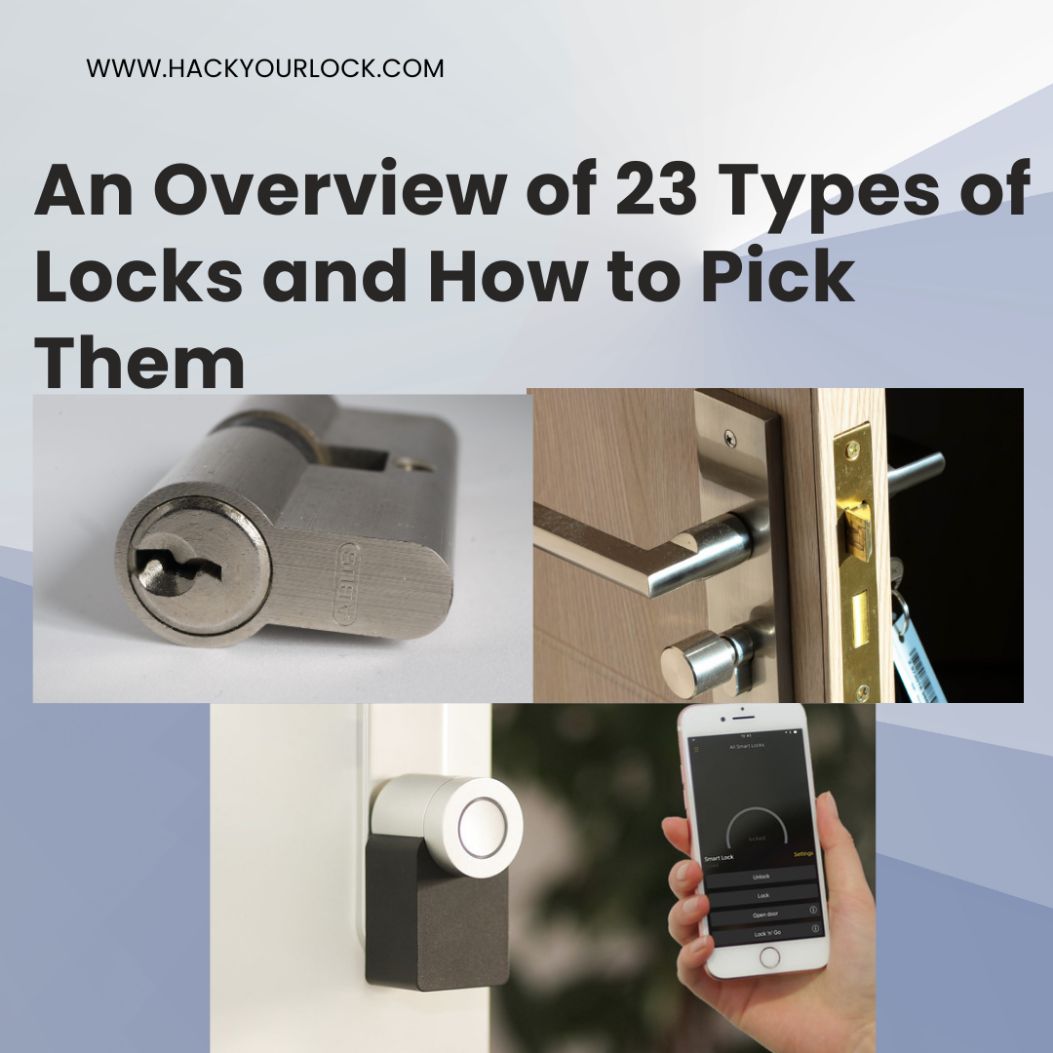
As the article finishes, you will land safely with a substantial understanding of types of locks, their pros and cons, and how to crack them open. With this knowledge, you’ll be better equipped to secure your home, business, or personal belongings and protect yourself from any potential intruders.
So, buckle up and get ready to dive into the world of locks with me, Emma Marshal, your trusted guide to lock picking and security. Let’s get started!
Contents
- 1 Types of Locks with Purpose-Based Classifications
- 1.1 1. Internal Door Locks
- 1.2 2. Front Door Locks
- 1.3 3. Key Locks
- 1.4 4. Locks for Lockers
- 2 Other Types of Locks
- 3 Conclusion
- 4 FAQ’s
- 5 Resources
Types of Locks with Purpose-Based Classifications
Locks are an essential component of our daily lives, providing security and peace of mind in a world that can be unpredictable. There are many types of locks available, having their unique purpose and qualities.
The various types of locks based on their purpose and an overview of their characteristics and functions is defined below in detail.
1. Internal Door Locks
Internal door locks provide security for interior doors such as bedrooms, bathrooms, and closets. They are usually knob locksets or lever handle locksets and may come in various finishes and security levels.
Types of Internal Door Locks
Knob Locks, Lever Handle Locks, Barrel Bolt, Deadbolt locks, Disc tumbler locks, Lever Handle Lock, Sliding Door Locks, and Latch, are classified as internal door locks, as they are commonly used to secure interior doors within a building or home.
-
Knob Locks
Knob locks are among the type of locks that are part of interior doors. They consist of a knob on one side of the door that turns to lock or unlock the door, and a keyhole on the other side for use with a physical key.
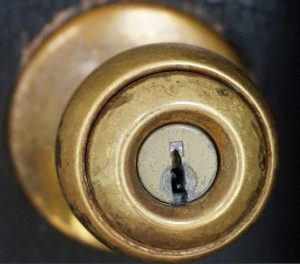
As an internal lock, knob locks offer a relatively low level of security and are not recommended for use on external doors. However, they are a cost-effective and easy-to-install type of locks for securing bedrooms, bathrooms, and closets within a home or office.
Pros of Knob Locks
- One of the main advantages of knob locks is their simplicity. Their maintenance requirements are minimal and are easy to operate.
- Knob Locks are available in a variety of finishes and styles to match the décor of your home or office.
Cons of Knob Locks
- Knob locks are susceptible to picking and bumping, which can compromise their security
- Knob Locks can be easily forced open with a wrench or other tools, making them a less secure option than other types of locks.
How to Pick Knob Locks
Following are the steps to pick a doorknob lock:
- Insert a tension wrench into the keyhole of the lock.
- Turn the tension wrench to find out which is the right direction for it to go.
- Now above the tension wrench, you are supposed to insert a pick.
- Use the pick to feel for the pins in the lock.
- Use gentle but steady pressure to lift each pin until it clicks into place.
- Move on to the next pin and repeat until all pins have been lifted.
- Turn the tension wrench to open the door.
- Remove the wrench and pick from the lock.
Knob locks are a popular and affordable option for internal doors but they are not suitable for high-security applications.
-
Lever Handle Locks
Lever handle locks are a type of lock often used for interior doors, and are commonly found in commercial or office settings. They consist of a handle that is pushed down to open the door, along with a keyhole that can be used to lock and unlock the door.
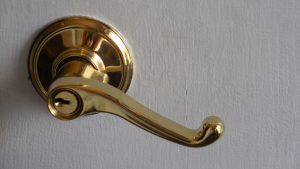
Pros of Lever Handle Locks
- Lever Handle Locks are easy to use for people with mobility or dexterity issues, as they do not require turning a knob.
- They are more durable than knob locks due to their design.
- Lever Handle Locks exist in many styles to collaborate with the design of a room.
Cons of Lever Handle Locks
- Lever Handle Locks can be more expensive than other types of locks.
- Their handle can be easily grabbed with a tool or credit card to gain access without a key.
- They are not as secure as deadbolts, which are often used in combination with lever handle locks.
How to Pick Lever Handle Locks
- Place a tension wrench into the keyhole’s bottom and then later exert force in a way that makes the key spin, in its direction.
- Feel for the pins with a pick inserted above the wrench.
- Apply upward pressure on each pin with the pick until it sets into place.
- Once all of the pins are in place, crank the tension wrench in the same way that the key would turn to unlock the door.
- Remove the wrench and pick from the lock.
Overall, lever handle locks are a convenient and stylish option for interior doors, but may not provide the highest level of security compared to other types of locks.
-
Barrel Bolt
Barrel bolts are a type of lock that is often used as a secondary locking mechanism on interior doors. They consist of a cylindrical barrel that slides into a bracket attached to the door frame.
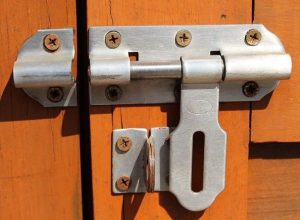
Pros of Barrel Bolt Locks
- Barrel Bolt Locks have a very easy installation process which is very inexpensive.
- They come in conjunction with other types of locks to provide additional security.
- Barrel Bolt Locks provide a visible indication that the door is locked.
Cons of Barrel Bolt Locks
- Barrel Bolt Locks can be easily bypassed with a tool or by force.
- It is less secure when compared with other types of locks like deadbolts.
- They possess limited use as a primary locking mechanism due to their size and ease of bypass.
How to Pick Barrel Bolt Locks
- Place a tension wrench into the keyhole. Later put pressure to turn the barrel, in the required direction.
- Now you have to put inside the pick above the wrench so that you can feel the pins.
- Apply upward pressure on each pin with the pick until it sets into place.
- Once all pins are set, turn the tension wrench in the direction the barrel would turn to unlock the door.
- Remove the wrench and pick from the lock.
Barrel bolts are a simple and inexpensive option for providing an additional layer of security on interior doors, but should not be relied on as the sole locking mechanism.
It is important to consider the specific needs of the situation when selecting a type of lock and to use barrel bolts in conjunction with other types of locks for maximum security.
-
Pin tumbler locks
Pin tumbler locks are among the most often utilized types of locks in residential as well as business settings. They are made up of a cylinder with a set of spring-loaded pins that prevent the cylinder from spinning until the proper key is inserted.

Pros of Pin Tumbler locks
- Pin tumbler locks are widely available and affordable.
- Installation of Pin Tumbler Locks is easy and use is also very convenient.
- They have the advantage of getting rekeyed if required.
Cons of Pin Tumbler lock
- Pin tumbler locks can be picked by experienced burglars using specialized tools or techniques.
- Keys can be easily duplicated if they fall into the wrong hands.
- It has limited resistance to forced entry compared to more secure types of locks.
How to Pick Pin tumbler lock
- The first step is to select the right tool for the lock and like other types of locks, a tension wrench is the most suitable choice on the first attempt. You need to place a tension wrench into the hole of the key. Later pressurize it in the direction where you feel that the key would turn.
- Then use a pick placed above the wrench to feel the pins.
- Apply upward pressure on each pin with the pick until it sets into place.
- Once you know about all the pins which are set, rotate the tension wrench in the direction of the turning key for unlocking the lock.
- Remove the wrench and pick from the lock.
Pin tumbler locks are a popular and widely used option because they are affordable and easy to use. However, they may not provide adequate security in high-risk situations and are vulnerable to picking and duplication.
-
Disc Tumbler Lock
A Disc Tumbler Lock is a type of key-operated lock that uses rotating discs or plates, each containing slots of different shapes, to prevent the lock from opening without the correct key.
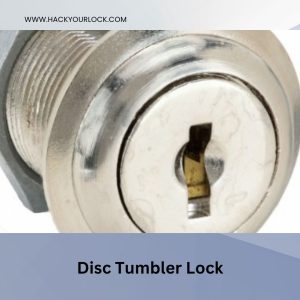
When the key is inserted into the lock, it aligns the slots in the discs to create a shear line, allowing the lock to turn and unlock. The unique shape of the key makes it difficult to pick the lock using traditional lock-picking tools.
Pros of Disc Tumbler Lock
- Disc Tumbler Locks are difficult to pick due to their unique key shape
- They are both long-lasting and cost-effective.
Cons of Disc Tumbler Lock
- The security feature is not as secure as other lock types
- It has possible vulnerability to drilling attacks
- Limited key variation makes it easier to duplicate keys
How to Pick Disc Tumbler Lock
The following steps can be used to pick the disc tumbler lock:
- Go for the tension wrench insertion into the keyhole. Apply pressure in the same direction as that of the key.
- Insert the pick into the keyhole and feel for the discs.
- Apply upward pressure on each disc with the pick until they align in the correct position.
- Once all discs are aligned, turn the tension wrench in the direction the key would turn to unlock the lock.
- Remove the wrench and pick from the lock.
-
Warded Lock
A Warded Lock is a type of lock that utilizes a collection of metal “wards” to obstruct the keyway in order to avoid the lock from being opened without the right key. The key has a specific shape that can bypass the wards and engage the lock mechanism.
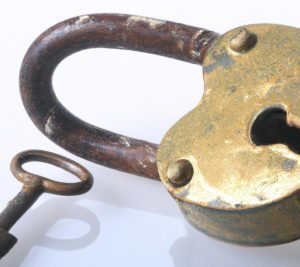
Pros of Warded Locks
- Warded locks are relatively simple and inexpensive, making them a popular choice for low-security applications such as cabinets, lockers, and padlocks.
- They are easy to install and maintain and do not require complex mechanisms or electronics to operate.
- One of the advantages of warded locks is that they can be difficult to pick without the correct key.
- The wards inside the lock prevent most lock picking tools from reaching the pins, making it harder for an intruder to open the lock. However, skilled lock pickers can use specialized tools such as skeleton keys or warded lock picks to bypass the wards and open the lock.
- These locks do not require a lot of maintenance.
Cons of Warded Locks
- Warded locks have limited key variation. Since the key has to navigate around the wards, there are only a few possible combinations for the key’s shape. This makes it easier to duplicate keys, and can also make it easier for someone to find a key that will fit the lock without having the original key.
How to Pick Warded Locks
How to pick a warded lock is discussed below:
- Use tension wrench to apply pressure in the direction of key rotation.
- Insert the pick into the keyhole and feel for the warding.
- Apply pressure to the pins in the keyway until the pick finds the correct path through the warding.
- Move tension wrench in the direction of unlocking the key.
- Remove the wrench and pick from the lock as the lock opens.
-
Sliding Door Locks
Sliding door locks are locks that are used to secure sliding doors or windows. They are usually installed on the interior side of the door or window and work by using a latch that slides into a corresponding hole in the frame.
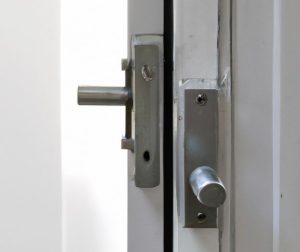
Some sliding door locks may also have additional features such as a key lock or a security bar to further increase the level of security.
Pros of Sliding Door Locks
- Sliding Door locks are easy to use
- Good for securing large sliding doors or windows
- Sliding door locks are available in a range of sizes and materials
Cons of Sliding Door Locks
- Sliding door locks can be easily bypassed if the lock is not properly installed or maintained
- Not as secure as other lock types
- Some models can be difficult to operate
How to Pick Sliding Door Locks
Sliding door locks can be picked in the following way:
- Insert the appropriate tool into the lock and manipulate it until the lock releases.
- If the lock is a cylinder lock, use a tension wrench and pick to manipulate the pins in the keyway.
-
Latch
A latch lock is a type of lock that works by using a latch mechanism to keep a door or window closed. The latch is typically located on the inside of the door or window and can be easily released from the inside by turning a knob or lever.
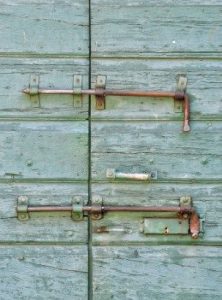
Pros of Latch Locks
- Latch locks are simple and easy to use, making them ideal for interior doors that don’t require a high level of security.
- They are typically one of the most inexpensive types of locks available.
- They are quite simple to install, especially for individuals with little to no DIY knowledge.
Cons of Latch Locks
- Latch locks are not very secure, as they can be easily bypassed with a credit card or similar object that can be inserted between the latch and the strike plate.
- Some models of latch locks can be difficult to install properly, which can lead to issues with the lock functioning correctly.
- They are not suitable for use on exterior doors or other areas where high-level security is needed.
How to Pick Latch Locks
- Insert a thin tool, such as a credit card or small screwdriver, between the door and the frame.
- Use the tool to push the latch back into the door.
- Pull the door open once the latch is disengaged.
2. Front Door Locks
Front door locks are locks specifically designed for securing the main entrance door of a home or building. These locks are typically more durable and secure than internal door locks, as they need to withstand harsh weather conditions and protect against potential intruders.
Types of Locks for Front Door
Smart locks, Electronic locks, deadbolts, and Electromagnetic locks are classified as front door locks, as they are commonly used to secure entry doors to homes or buildings. Other front door locks will be discussed in types of key locks.
-
Smart Lock
Smart locks are advanced electronic door locks that offer more options for locking and unlocking doors. They are equipped with a keypad and can be unlocked using a key fob or smartphone.
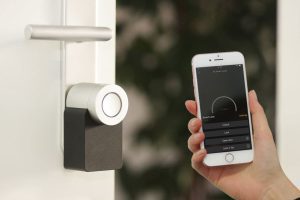
The primary advantage of a smart lock is the ability to connect it to home automation services via Wi-Fi or Bluetooth. However, these locks need a source of power to utilize their features, and regular battery replacements are required.
Pros of Smart Lock
- Convenient and easy to use, especially with features like remote locking and unlocking
- Other people can have access to it if you are out somewhere, with your permission.
- Such locks are readily integrated with Alexa or Google Home which are the popular home automation systems.
- Smart locks ensure extra security by keeping track of who has entered and exited the house.
- Some models have backup batteries in case of power outages
Cons of Smart Lock
- Smart locks are much more expensive to afford than traditional locks
- Require regular maintenance, such as battery replacements
- They do possess the potential for cybersecurity risks, such as hacking
- Some models of smart locks may be more complicated to install or set up for homemakers.
How to Pick Smart Lock
Some smart locks can be picked, although it can be more challenging than traditional mechanical locks. Smart locks typically have multiple layers of security, such as encrypted wireless communication and unique access codes, which can make them more resistant to picking.
However, if a hacker can bypass these security measures, they may be able to unlock the smart lock. It is important to note that attempting to pick a smart lock without authorization is illegal and can result in criminal charges.
-
Electronic Lock
Electronic locks are a type of front lock that uses electronic components to allow access.No traditional keys are used for these types of locks. They operate with a keypad or a smartphone or a key fob. Instead of a traditional key, electronic locks use a keypad, key fob, or smartphone to unlock the door. Some models can also be controlled through home automation services.
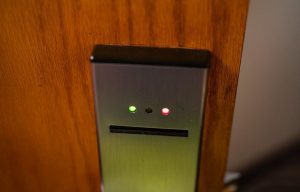
Pros of Electronic Lock
- Convenience – Access to the electronic locks allow are easy and convenient because they don’t require any keys to access them.
- Control – Electronic locks can be controlled remotely through a smartphone or home automation service, allowing for greater control over who can access the property.
- Customization – Multiple user codes, each with a different degree of access, can be programmed into electronic locks.
- Security – Some electronic locks have features such as biometric scanning or tamper alarms, adding an extra layer of security.
Cons of Electronic Lock
- Dependence on power – Electronic locks require a power source, either through batteries or wiring. If the power source fails, the lock may not work.
- Vulnerability to hacking – Electronic locks are vulnerable to hacking attempts, and malicious individuals may attempt to bypass the security features of the lock.
- Cost – Because of the additional functionality and electronic components, electronic locks can be more costly than standard locks.
- Complexity – Electronic locks may be more complex to install and operate than traditional locks.
How to Pick an Electronic Lock
Electronic locks are typically more difficult to pick than traditional locks due to their electronic components.
However, it is still possible to bypass an electronic lock using techniques such as hacking or exploiting vulnerabilities in the lock’s software.
It is important to use a reputable and secure electronic lock to minimize the risk of unauthorized access.
-
Deadbolt Lock
A deadbolt lock is a type of lock that is mounted independently of the doorknob and penetrates over the doorjamb, making entry more difficult for the burglars or unwanted intruders. It is commonly used as a front door lock because of its added security.
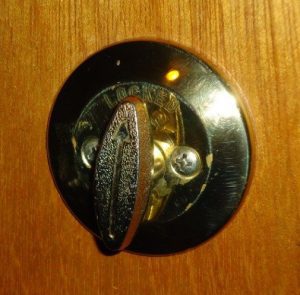
Pros of Deadbolt Lock
- Deadbolt locks are considered more guarded than other types of front door locks because they cannot be picked or pushed open quickly.
- It is available in a number of configurations, including single-cylinder, double-cylinder, and keypad.
- Dead Bolt Locks provide added protection against break-ins
Cons of Deadbolt Lock
- Dead Bolt Locks are more expensive than other types of front door locks and can be difficult to install for those without experience
- To unlock from the outside, a key is required, which might be cumbersome.
How to Pick Deadbolt Lock
The steps to pick a deadbolt lock are mentioned below:
- Obtain proper authorization: Before attempting to pick a deadbolt lock, it is important to have legal permission to do so. This includes owning the property where the lock is installed or having written permission from the property owner.
- Gather necessary tools: A tension wrench and a pick are required to pick a deadbolt lock. These tools can be purchased from hardware stores or online.
- Insert the tension wrench: The tension wrench is placed into the keyhole’s bottom and applied with slightest of the pressure in the same direction as the key is rotated to unlock the lock.
- Insert the pick: Insert the pick above the tension wrench and feel for the pins. The pins will be located on the side of the cylinder closest to the keyhole.
- Move the pins: Use the pick to move the pins up and down until they align with the shear line. This will require applying slight pressure to the tension wrench to create tension in the lock cylinder.
- Turn the lock: Once all pins are aligned with the shear line, turn the lock with the tension wrench to unlock the deadbolt.
-
Electromagnetic locks
An electromagnetic lock, also known as a “Maglock”, is an electronic lock consisting of an electromagnet and an armature plate.
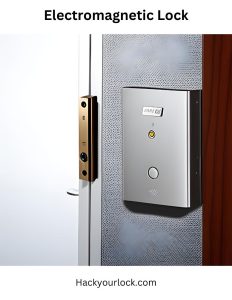
When electricity is applied, the electromagnet creates a magnetic field that attracts the armature plate, which in turn locks the door.
Pros of Electromagnetic locks
- Highly secure and does not have any requirement of a physical key to lock and unlock the door.
- Installation is easy but operating it is super easy.
- It can be integrated with access control systems.
Cons of Electromagnetic locks
- Electricity is a must to have so that it can function properly.
- Electromagnetic locks are expensive compared to other types of locks.
- Hardware for installation is an added requirement in the case of these locks.
How to Pick Electromagnetic Locks
Picking an electromagnetic lock is not as simple as traditional lock picking methods, as it involves bypassing the electronic components of the lock rather than manipulating physical pins.
This requires advanced knowledge and specialized tools, and attempting to pick an electromagnetic lock without proper authorization is illegal and can lead to serious consequences.
It is recommended to only use electromagnetic locks in conjunction with other security measures for maximum protection.
3. Key Locks
Key locks are locks that require a physical key to operate. They are one of the most common types of locks and are used in various settings, such as homes, businesses, and vehicles.
Key locks are typically designed with a cylindrical or tubular shape and have a keyhole or keyway where the key is inserted to unlock or lock the device.
When a key is inserted and turned, it activates a series of internal mechanisms that either engage or disengage the locking mechanism, allowing the lock to be opened or closed.
Types of Key Locks
Internal Door Locks such as Lever Handle Locks, Pin tumbler locks, warded locks, and door knob locks are also classified as key locks. Other key locks include front door locks like cylinder locks, Mortise locks, deadbolt locks, Rim locks, and locker locks such as cam locks.
Internal door locks which are also key locks have been defined earlier in this article. Front door locks and locker locks which are also key locks are discussed below:
-
Cylinder Locks
Cylinder Locks are one of the most commonly used types of locks. They consist of a cylinder that contains a series of pins of varying lengths, which must be aligned properly with the correct key to unlock the door.
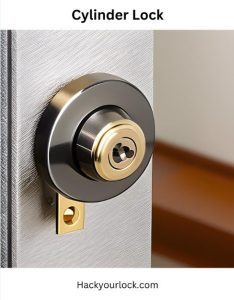
Pros of Cylinder Locks
- Widely available and affordable
- Offers a high level of security when paired with the right deadbolt
- Can be easily rekeyed without replacing the entire lock
- Compatible with a variety of key types and styles
Cons of Cylinder Locks
- Can be vulnerable to picking and bumping if not paired with a quality deadbolt or used with a high-security cylinder
- Some cheaper models may be prone to breaking or wearing down over time
- Cylinder locks with a single shear line can be bypassed with special tools, making them less secure
How to Pick Cylinder Locks
Picking a cylinder lock can be done with specialized tools, including a tension wrench and a pick.
The process involves applying tension to the cylinder with the wrench while using the pick to lift and manipulate the pins into the correct position to open the lock.
-
Mortise Lock
A mortise lock is a type of lock that is positioned at the edge of a door within a mortise. It is normally controlled with a key and consists of a lock body, a keyhole, a latch bolt, and a deadbolt. Mortise locks are commonly found in older homes and structures and can be utilized for both residential and commercial reasons.
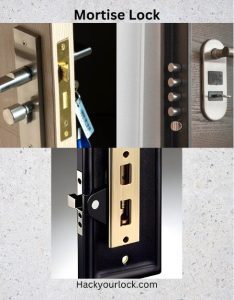
Pros of Mortise Locks
- High security: Mortise locks provide a high level of security as they are difficult to pick and tamper with.
- Durability: Mortise locks are generally made of high-quality materials and are built to withstand heavy use and abuse.
- Versatility: Mortise locks can be used on a wide variety of doors, including wood, metal, and glass.
Cons of Mortise Locks
- Installation: Mortise locks can be difficult to install and may require professional installation.
- Maintenance: These locks require regular maintenance to keep them functioning properly.
- Cost: Mortise locks can be more expensive than other types of locks due to their high quality and durability.
How to Pick Mortise Locks
Picking a mortise lock can be a bit more challenging than picking other types of locks due to its complex design, but it’s still possible with the right tools and techniques. Here are some additional details on how to pick a mortise lock step-by-step:
- Insert the tension wrench and pick to begin with the basic process of lock picking.
- Insert the pick tool into the keyhole above the tension wrench and gently lift each pin to determine the binding order.
- Begin to apply pressure with the tension wrench while lifting each pin in the binding order until all pins have been set.
- If necessary, release tension and reset pins that have dropped.
- Once all pins are set, turn the tension wrench in the direction of the key turning to unlock the mortise lock.
-
Rim locks
A rim lock is a surface-mounted lock that is attached to the inside face of a door. Its key-operated bolt locks the door to the frame.
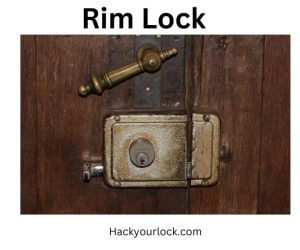
Pros of Rim Locks
Pros include simple installation and lower cost compared to other types of locks.
Cons of Rim Locks
Cons include easier bypassing with brute force, and it can be vulnerable to lock picking.
How to Pick Rim Locks
To pick a rim lock, one must insert a tension wrench into the keyhole, apply tension, and use a pick tool to manipulate the pins until the lock opens.
-
Cam Locks
Cam locks are a type of locking mechanism which is key based and commonly used in cabinets, drawers, and other types of furniture. They consist of a metal cylinder with a cam that rotates to lock or unlock the device.
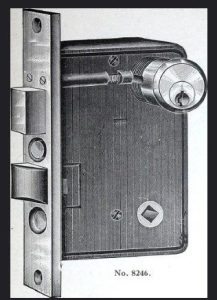
Pros of Cam Locks
Cam locks are available in various sizes and types, such as key-operated and combination locks. They are easy to install and provide basic security for low-risk applications.
Cons of Cam Locks
They are not as secure as other types of locks and can be easily bypassed with basic lock-picking tools.
How to Pick Cam Locks
A tension wrench and a pick can be used to twist the pins within a cam lock to pick it. Insert the tension wrench into the bottom of the keyhole and gently crank the lock to turn it slightly. Then, use the pick to push each pin up and set it in place. Continue manipulating the pins until all of them are set, and the lock will turn and open.
4. Locks for Lockers
The type of locks for lockers is defined below:
Types of Locks for Lockers
-
Padlock
Padlocks are portable locks that can be used for a variety of purposes, including securing doors, gates, lockers, and more. They consist of a shackle that can be opened and closed by a key, combination, or electronic code.

Pros of Padlock
The advantage of padlocks is their versatility and ease of use. It is important to choose a high-quality padlock with a strong shackle and locking mechanism and use it in combination with other types of locks for added security.
Cons of Padlock
They are also vulnerable to picking and shimming, which can compromise their security.
How to Pick Padlock
To pick a padlock, insert a rake tool and tension wrench. Use the rake to mimic the key’s peaks and valleys, inserting and pulling it out quickly while applying tension on the wrench. Try different rake designs to find the best fit. Keep trying until the lock pops open. There are other DIY techniques to pick a padlock as well.
-
Combination lock
A combination lock is a type of lock that opens by entering a series of numbers or symbols. It is commonly used on safes, luggage, and gym lockers. The downside is that the lock can be cracked by trying different combinations.
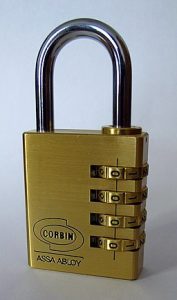
There are two types of combination locks: dial combination locks and digital combination locks. To pick a combination lock, you would need to use either brute force or a method called cracking, which involves manipulating the lock to figure out the correct combination.
Pros of Combination Locks
The advantage of a combination lock is that there is no need for a key, making it difficult to pick. However, it is important to remember the combination.
Cons of Combination Locks
The downside is that the lock can be cracked by trying different combinations
How to Pick Cylinder Locks
To pick a combination lock, you would need to use either brute force or a method called cracking, which involves manipulating the lock to figure out the correct combination.
- Brute Force: This involves trying every possible combination until the lock opens. This method can be time-consuming and can damage the lock, but it can work if the combination is short or simple.
- Cracking: This method involves listening or feeling for the click or movement of the lock’s internal mechanism as you turn the dial, which can give you clues about the correct combination. Another method is to use a decoding tool, which can help you figure out the combination by feeling for the location of the internal components.
- Manipulation: This method involves carefully manipulating the lock’s internal components to align them and determine the correct combination. This requires a specialized tool and skill, but it is the most precise and least damaging method.
If you are new in practicing lock picking and have gained better knowledge about types of locks through this article then you must also checkout my tips and tricks to enhance your lock picking skills.
More details can be availed from TYPES OF LOCKS.
Other Types of Locks
- Jimmy Proof Deadbolt: A surface-mounted lock that uses interlocking bolts to secure the door.
- Euro Profile Cylinders: A type of cylinder lock commonly used in Europe.
- Wall Mounted Locks: A lock that is mounted directly onto a wall or other flat surface.
- Furniture Locks: A type of lock specifically designed for use on furniture, such as desks and cabinets.
- Vending/T-Handle Locks: A type of lock commonly used on vending machines and other commercial applications.
Pros and Cons of Other Types of Locks
| Type of Lock | Pros | Cons |
| Jimmy Proof Deadbolt | Easy to install, provides security | Not as secure as other types of deadbolts |
| Euro Profile Cylinders | Offers a high level of security, compatible with various lock systems | Can be expensive |
| Wall Mounted Locks | Provides added security, versatile | Can be difficult to install |
| Furniture Locks | Provides added security | Not as secure as other types of locks |
| Vending/T-Handle Locks | Easy to use, provides security | Can be susceptible to picking and tampering |
Apart from this article, The Four Types of Lock by Deviant Ollam is a good resource to study.
Conclusion
So, that’s the rundown on 23 types of locks and how to pick them. As a lock picking expert, I’ve seen it all and I can tell you that the right lock can make all the difference when it comes to keeping your property safe and secure.
Remember to choose a lock that fits your specific needs and budget, and always be mindful of security risks. And of course, never pick a lock that you don’t own or have permission to access! Stay safe, folks.
FAQ’s
Q1: What type of lock is best for a residential property?
A: For residential properties, deadbolts are a popular choice for their sturdiness and reliability.
Q2: Are smart locks a good option for home security?
A: Yes, smart locks offer convenience and security with features such as remote access and keyless entry.
Q3: Can all locks be picked?
A: No, some high-security locks have features that make them nearly impossible to pick, but it’s always best to have multiple layers of security to ensure maximum protection.
Q4: What is the best type of lock for home security?
A: There is no one-size-fits-all answer to this question, as the best type of lock for home security depends on a variety of factors such as the level of security required, the type of door or window being secured, and personal preference. It’s important to do research and consult with a security professional to determine the best lock for your specific needs.
Resources
- Lock Picking: A Beginner’s Guide to Covert Entry by JORDAN SMITH
- Research on Pin Tumbler Locks and the Characteristics of Surface Traces Formed by Unlocking Guns By Gao Yi 1 Jin Yifeng 2, * Bai Yanping 2, * Mei Hongcheng 2 Xu Zhen 2
- How to Open Locks with Improvised Tools Practical, Non-Destructive Ways of Getting Back Into Just about Everything When You Lose Your Keys By Hans Conkel · 2001
- HOW TO PICK A LOCK S.T.E.M. Kit
- BEGINNERS GUIDE TO LOCK PICKING March 11, 2019 by Ashley Adamant
- Locks: Centuries of Security
- The Four Types of Lock by Deviant Ollam
- TYPES OF LOCKS.
